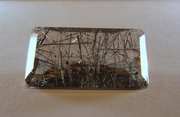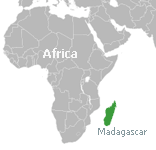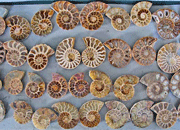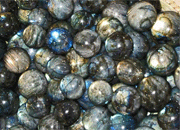Madagascar, as part of East Gondwana, split from Africa approximately 160 million years ago; the island of Madagascar was created when it separated from India 80 to 100 million years ago. Most archaeologists estimate that the human settlement of Madagascar happened between 200 and 500 A.D., when seafarers from southeast Asia (probably from Borneo or the southern Celebes) arrived in outrigger sailing canoes. Bantu settlers probably crossed the Mozambique Channel to Madagascar at about the same time or shortly afterwards. However, Malagasy tradition and ethnographic evidence suggests that they may have been preceded by the Mikea hunter gatherers.
The written history of Madagascar begins in the 7th century, when Arab Muslims established trading posts along the northwest coast. During the Middle Ages, the island's kings began to extend their power through trade with their Indian Ocean neighbours, notably East Africa, the Middle East and India. Large chiefdoms began to dominate considerable areas of the island. Among these were the Sakalava chiefdoms of the Menabe, centred in what is now the town of Morondava, and of Boina, centred in what is now the provincial capital of Mahajanga (Majunga). The influence of the Sakalava extended across what are now the provinces of Antsiranana, Mahajanga and Toliara. Madagascar served as an important transoceanic trading port for the East African Coast that gave Africa a trade route in the Silk Road a served simultaneously as a port for incoming ships. The wealth created in Madagascar through trade created a state system ruled by powerful regional monarchs known as the Maroserana. These monarchs would adopt the cultural traditions of subjects in their territories and would expand their kingdoms. They were given divine status and new nobility and artisan classes were created. Madagascar functioned in the East African Middle Ages as a contact port for the other Swahili seaport city-states such as Sofala, Kilwa, Mombasa and Zanzibar.
European contact began in the year 1500, when Portuguese sea captain Diogo Dias sighted the island after his ship separated from a fleet going to India. The Portuguese continued trading with the islanders and named the island as "Sao Lourenco" (St. Lawrence). In 1666, Francois Caron, the Director General of the newly formed French East India Company, sailed to Madagascar. The Company failed to establish a colony on Madagascar but established ports on the nearby islands of Bourbon and Ile-de-France (today's Reunion and Mauritius). In the late 17th century, the French established trading posts along the east coast.
From about 1774 to 1824, Madagascar was a favourite haunt for pirates, including Americans, one of whom brought Malagasy rice to South Carolina. Many European sailors were shipwrecked on the coasts of the island, among them Robert Drury whose journal is one of the only written depictions of life in southern Madagascar during the 18th century.
Sailors sometimes called Madagascar "Island of the Moon", a name by which it is referenced in the 1988 single "Orinoco Flow (Sail Away)" by artist Enya.
|
Andrianampoinimerina |
Radama I |
Ranavalona I |
Radama II |
|
Rasoherina |
Ranavalona II |
Ranavalona III |
Beginning in the 1790s, Merina rulers succeeded in establishing hegemony over most of the island, including the coast. In 1817, the Merina ruler and the British governor of Mauritius concluded a treaty abolishing the slave trade, which had been important in Madagascar's economy. In return, the island received British military and financial assistance. British influence remained strong for several decades, during which the Merina court was converted to Presbyterianism, Congregationalism and Anglicanism.
With the domination of the Indian Ocean by the Royal Navy and the end of the Arab slave trade, the western Sakalava lost their power to the emerging Merina state. The Betsimisaraka of the east coast also unified, but this union soon faltered.
France invaded Madagascar in 1883, in what became known as the first Franco-Hova War seeking to restore property that had been confiscated from French citizens. (Hova is one of three Merina classes: andriana - aristocracy, hova - common people, andevo - slaves. The term hova was wrongly used by the French to mean Merina.) At the war's end, Madagascar ceded Antsiranana (Diego Suarez) on the northern coast to France and paid 560,000 gold stripers francs to the heirs of Joseph-Francois Lambert. In 1890, the British accepted the full formal imposition of a French protectorate.
In 1895, a French flying column landed in Mahajanga (Majunga) and marched to the capital, Antananarivo, where the city's defenders were taken by surprise, as they were expecting an attack from the much closer east coast. Twenty French soldiers died fighting and 6,000 died of malaria and other diseases before the second Franco-Hova War ended.
After the conclusion of hostilities, in 1896 the French Parliament voted to annex Madagascar. The 103-year-old Merina monarchy ended with the royal family being sent into exile in Algeria. In December 1904, the Russian Baltic Fleet docked at Antsiranana (Diego Suarez) for coal and provisions before sailing on to its doomed encounter with the Japanese fleet in the Battle of Tsushima. Before leaving port, the Russian sailors were required to put ashore the animals they had acquired, including monkeys, boa constrictors and one crocodile.
During World War II, Malagasy troops fought in France, Morocco, and Syria. Just before the fall of France, Germany planned to forcibly deport all of Europe's Jews to Madagascar in what was known as the Madagascar Plan. But action on the plan was never begun. After France fell to Germany, the Vichy government administered Madagascar. During the Battle of Madagascar, British troops occupied the strategic island in 1942 to preclude its seizure by the Japanese, after which the Free French took over.
In 1947, with French prestige at low ebb, a nationalist uprising was suppressed after several months of bitter fighting with 90,000 people killed. The French later established reformed institutions in 1956 under the Loi Cadre (Overseas Reform Act), and Madagascar moved peacefully towards independence. The Malagasy Republic was proclaimed on October 14, 1958, as an autonomous state within the French Community. A period of provisional government ended with the adoption of a constitution in 1959 and full independence on June 26, 1960. In 2006 the country experienced an attempted coup.












